Fall 2018 the University Archives partnered with Media School professor emeritus Ron Osgood and his new Honors Course Archival Storytelling. His students spent several class sessions in the Archives researching a topic of their choice and crafting a blog post for inclusion here! Some students chose to provide overviews of collections while others dove into specific bits of IU Bloomington history, but all seemed to enjoy the experience. We’ll be sharing these posts in groups over the next few weeks. In order to ensure the student’s voices are heard, Archives staff did minimal editing on these pieces.
This is the last entry, so many thanks to Prof. Osgood and his class for these great pieces!
______________________
The History of Television at IU by Michelle Stallman and Alyssa Woolard
Even though television is an everyday part of life now, it has not always there to provide us with entertainment, inform us with news updates, and enlighten us with educational programming. Today, a student in the Indiana University Media School has the option to study a variety of media subjects, including not only the business of television, but also how to create television programs. Yet before we had the structure we have now, the Media School underwent numerous changes throughout its lifetime. The Department of Journalism, created in 1911, was the foundation of media studies at Indiana University, but it wasn’t until 1945, when the Department of Radio was founded, that studying newer forms of mass communication, specifically television, had a place in the curriculum at IU.
During the 1940s, television broadcasting was a new form of mass communication. Throughout this decade, only a handful of American households owned a television set, as they were very expensive, and therefore inaccessible, especially during wartime. In addition, there were not very many television networks for people to watch, and in many communities, there were no network signals that could reach them.
For almost the entirety of the 1940s, Bloomington did not have a local network. This changed on November 11th, 1949, when the city of Bloomington first broadcast WTTV. It was the second network in Indiana, with the only precedent being WFBM-TV (now known as WRTV) starting their broadcast in May of 1949, only four months prior. In its early years, WTTV operated as an NBC affiliate station before becoming an independent station in 1957. It has since gone through a number of affiliate changes, but it currently operates with CBS in the Indianapolis area, despite still being licensed to Bloomington.
As television rose in popularity and became more accessible to the general public in the early 1950s, people began to develop strong opinions and beliefs when it came to watching it. During these early days of television, limited access to content meant that television viewers did not have any control over what they watched, as seen in this letter to the editor from an Indiana newspaper. An Indianapolis resident describes his disdain with the programming available through WFBM-TV, which was, at that point in time, the only network available in the city. The writer describes often becoming bored with his television, turning to his radio for entertainment instead. This lack of programming meant that there was room for many more networks to be established so that viewers could have more variety and options when looking for entertainment, news, or education.

In an Indianapolis Times article from this period, a survey is summarized which asked television viewers how they pass the time during the commercial breaks of their favorite television programs. A common answer for women at the time was to do the dishes, while many men opted to take showers during the breaks. Other answers varied from talking with family members to reading. It seemed that only one person answered that they liked to watch the commercials. A common disdain for commercials may go back further than we think.
All of this increased interest in television as its popularity rose meant that this new form of media needed to be studied so that students could harness its power. Indiana University, specifically, was interested in not only the commercial uses for a television studio, but also the educational uses. For a number of years, members of IU’s staff championed for the addition of Television to the Department of Radio, only to be turned down at every corner. However, the university’s decision against adding a television curriculum was not a lack of importance on the subject, but rather a lack of funds.
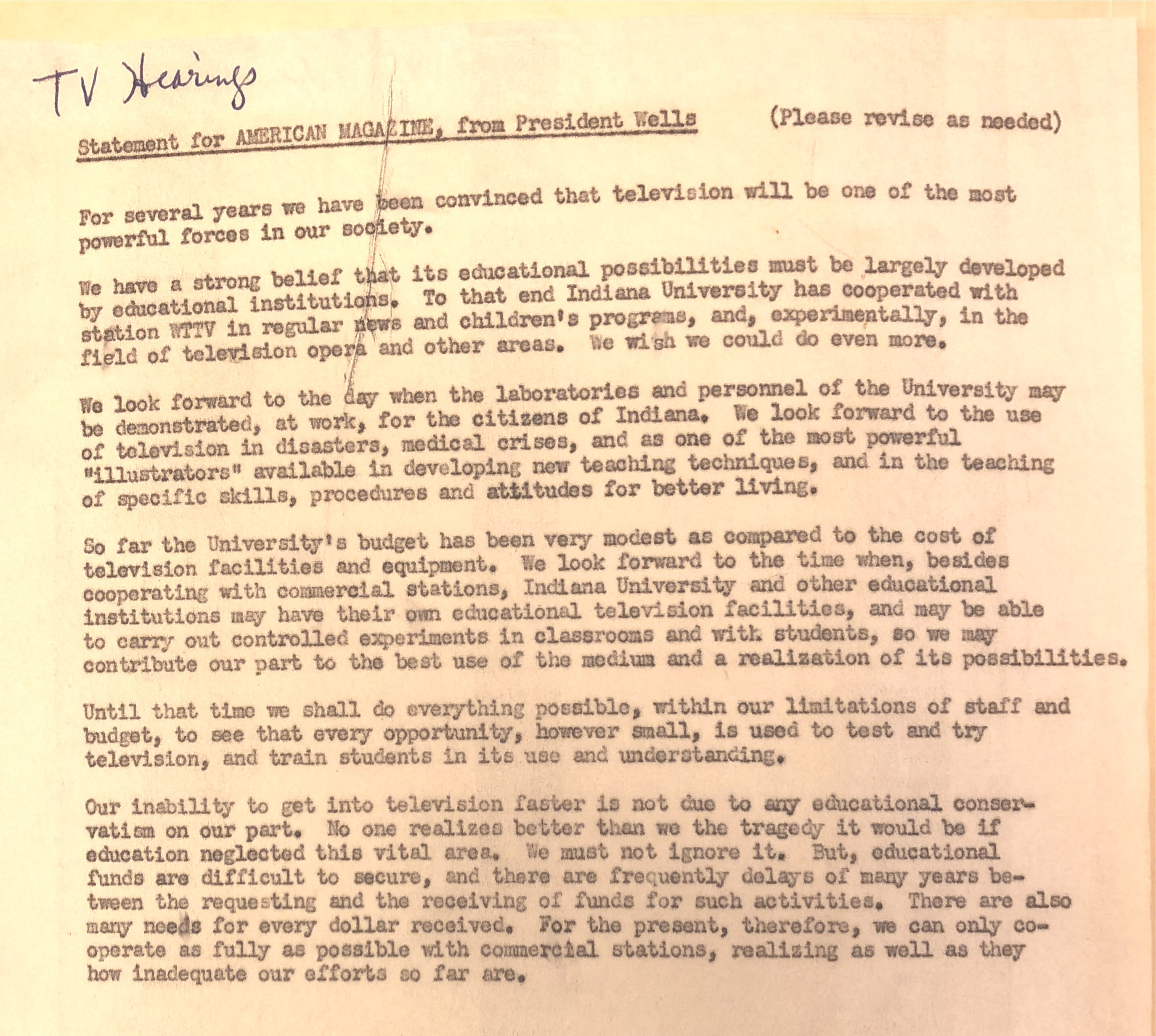
During a TV hearing in 1950, Herman B Wells, then the president of Indiana University, said on the matter: “So far the University’s budget has been very modest as compared to the cost of television facilities and equipment. We look forward to the time when, besides cooperating with commercial stations, Indiana University and other educational institutions may have their own educational television facilities.” In 1953, this dream for a TV department in the university became a reality. IU set aside $75,000 for the purpose of adding television to the Department of Radio, more than $49,000 of which was allocated solely to buy television equipment.
A likely contribution to the university finally accepting a television addition was their previous usage of television for educational purposes. Starting in 1954, classes were offered via television. Instead of having to physically show up to class, students could use their televisions to watch lectures and take courses remotely, much like how online classes are taken today. These programs were produced in the television studios at IU and were broadcast through Bloomington’s network, WTTV. The university used this technology to allow for larger class sizes by televising a lecture to other halls on campus. Because of this, a wider variety of courses were offered each semester through television, from English, to First Aid, to Art Appreciation.

With the introduction of television to the curriculum at the newly dubbed Department of Radio and Television, a number of different courses were developed that handled a variety of television-related subjects. Many of the courses offered in the late 1950s bear a strong resemblance to the courses current Media School students take. There were some classes that worked with television on a more foundational level, like “Television Production” and “Introduction to Radio and Television I”, while others dove into more specific realms of the TV world, like “Educational Writing for Radio and Television” and “Reporting and Newswriting for Radio and Television I”.
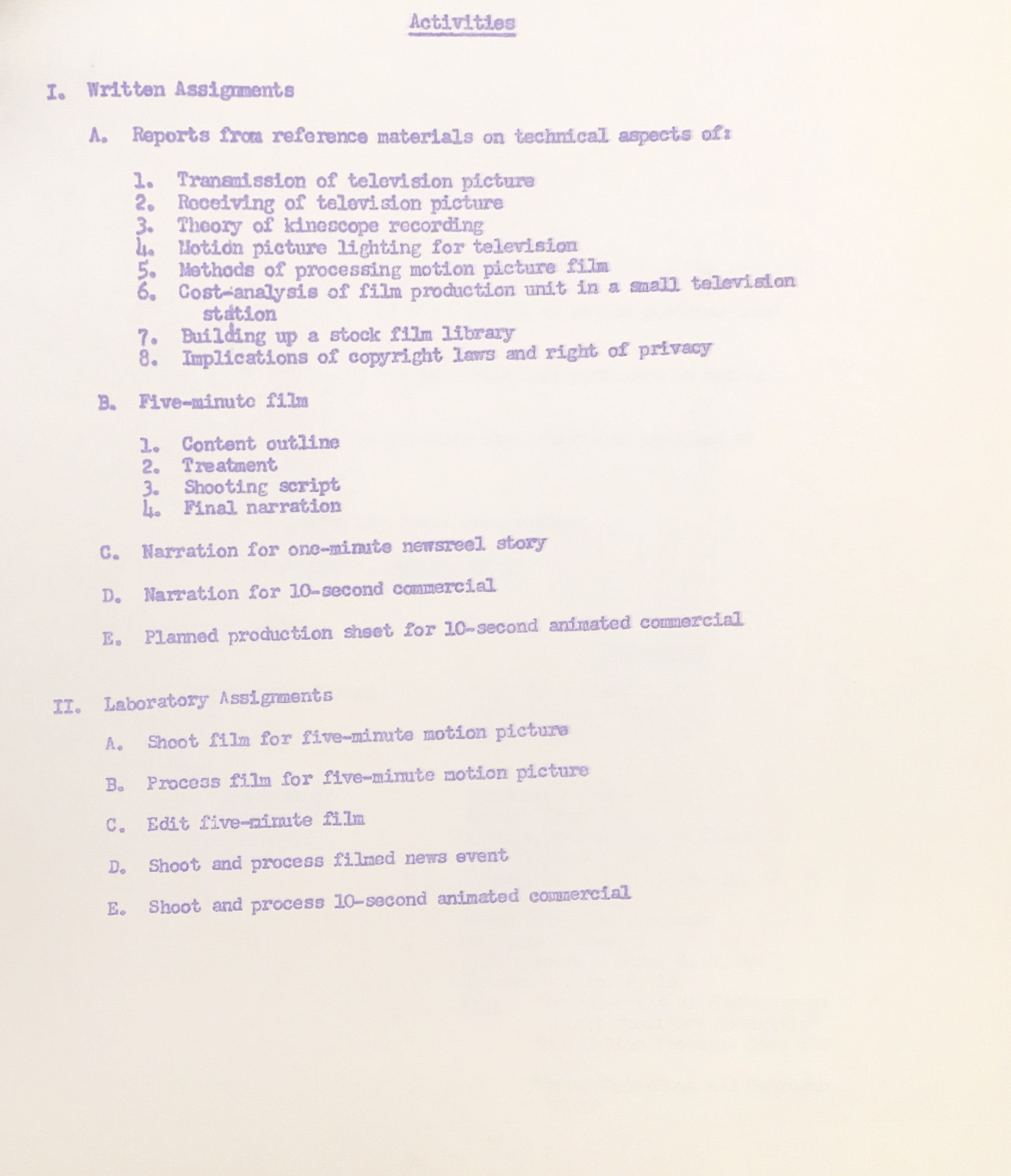
One such course was “Utilization of Television Films”, taught by William H. Kroll in the late 1950s. The idea behind the course was to teach both the theory and practice of making and using films for television. Kroll’s class taught the fundamental principles, production, and programming of films for television. Students learned in detail about topics like how to shoot and edit film, understanding copyright laws, and principles of film and television. Many of the points outlined in the syllabus resemble subjects taught in modern courses like “Introduction to Production Techniques and Practice,” a course that students can take now in the Media School to learn more about studio and field work for television. Even the activities resemble those completed in current courses.
Students tested their skills in writing narrations for newsreels and commercials, and they wrote essays about topics like copyright law. In the laboratory section of the class, students were able to practice shooting and processing a variety of films, like for a short film and for a news event. While how and where we consume television may have changed, many of the principles taught have remained the same.
Today, the Media School encapsulates a variety of subjects, including journalism, game design, production, and advertising, just to name a few. As the number of mass media forms has grown, so has Indiana University’s Media School. Originally just the Department of Journalism, the college grew to incorporate radio, television, film, video games, and digital media.
Although new forms of media have arisen, television continues to be a vital part of our culture today. Teachers continue to show educational films during classes, and television remains dominant in providing news to the people. However, as technology has advanced, distance learning has changed. Today, online courses are used to learn at home instead of television courses, but that does not change the impact and influence that they had over the education of today. While the television studios used by Media School students today may look a lot different than the ones used in the 1950s, they remain steadfast in the teaching and application of many of the same principles.
______________________
The Eggshell Press by Ethan Fields
When it comes to American History, there are very few decades that saw a cultural, political and social revolution equivalent to that of the 1960s. During this time period, civil and social unrest that had been brewing for years finally boiled over into all aspects of American life. From the civil rights movement and the Vietnam War, to music, the counterculture and political demonstrations, our nation was in the middle of a major shift that created ripples we still feel and see today. Almost all, if not every town and city in America felt the effects of the changes occurring in the 1960s, and Bloomington, Indiana was no different. As a college town, many demonstrations and rallies were taking place that protested the injustices our nation had were/had been promoting such as the Vietnam War, corrupt politicians/policies and systematic racism. And thanks to a single mimeograph machine, the people’s messages were able to be spread across campus and the town of Bloomington.
This mimeograph machine went by the name of the Eggshell Press and was active from the fall of 1967 to August of 1968. Residing in a spare bedroom belonging to Carol B. Chittenden and her husband, this machine printed everything from flyers to memorandums that were passed out during and after vigils, marches, demonstrations and rallies. It is interesting to note that the machine got its name when people suggested that the materials being printed off should be copyrighted. In order to copyright the materials, though, a publisher was mandatory and so the machine and organization became known as the Eggshell Press. This organization was very special and unique in the sense that no single group was responsible for or owned the machine. Instead, student groups used the machines when they had a message they wanted to get out so their voices could be heard. Examples of issues the Eggshell Press addressed include the Vietnam War, draft resistance, the assassination of Robert Kennedy and Martin Luther King Jr., and other major cultural events that occurred during this time period.
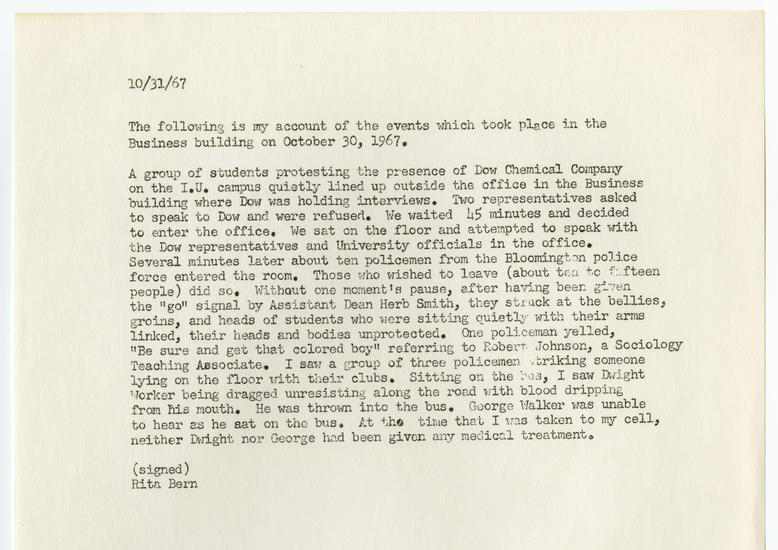
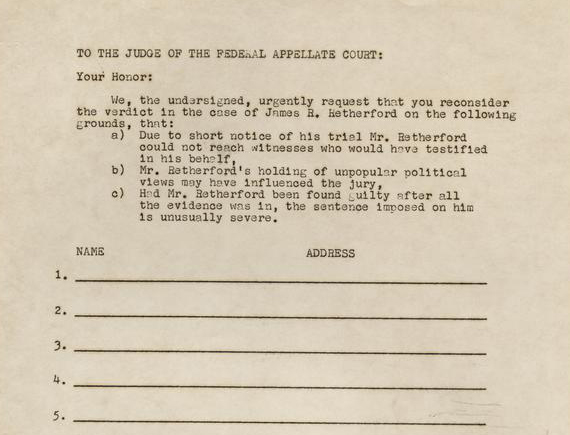
As evident from the subject matter being printed, a majority of the student groups using the machine could be considered part of the “New Left.” But while this is the case, there are two distinct “series” that were printed by the Eggshell Press during its lifespan. The first series, now referred to as “Organizations”, consisted of publications made by student run organizations at Indiana University such as the Students for Democratic Society, the Committee to End the War in Vietnam and the Progressive Reform Party. These organizations produced materials that voiced liberal views on several issues that were occurring in the United States during the mid to late 60’s, such as the ones listed above. A second series, which is now referred to as “Subjects”, contains materials that discussed topics such as the ones listed above along with the Dow Recruitment demonstration and James Retherford, who was once the editor-in-chief of an underground student newspaper known as The Spectator. All of these topics had a “New Left”/liberal perspective as well with the “Subjects” series being more information based than the “Organizations” series. This is because the materials printed during this series not only touched upon important social movements that were occurring at the time, but other “miscellaneous” events that were not related to protests or any other major movements. The documents recorded under “miscellaneous” reveal and discuss subjects such as financial transactions and a graduate student petition to President Stahr.
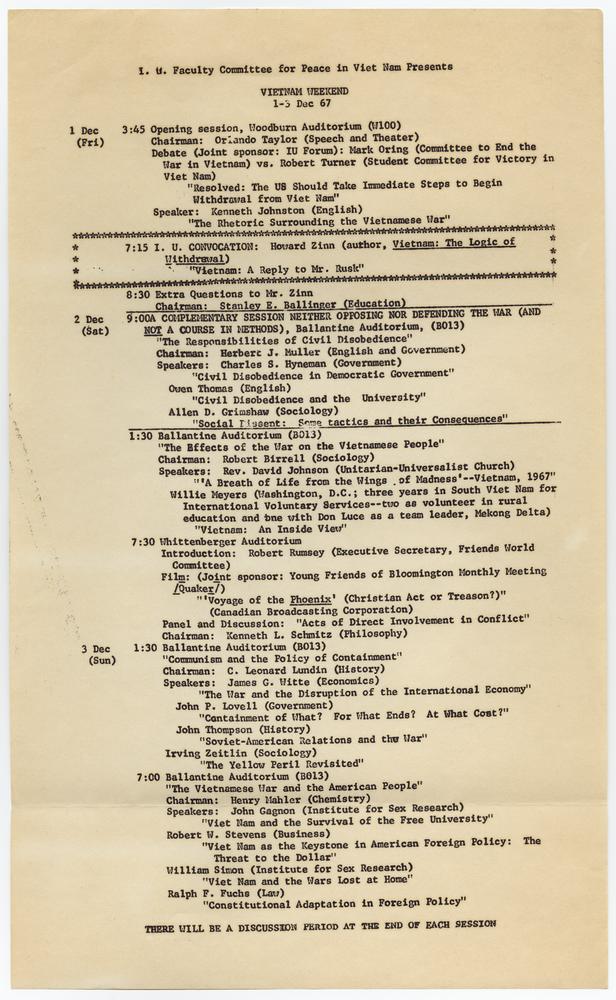
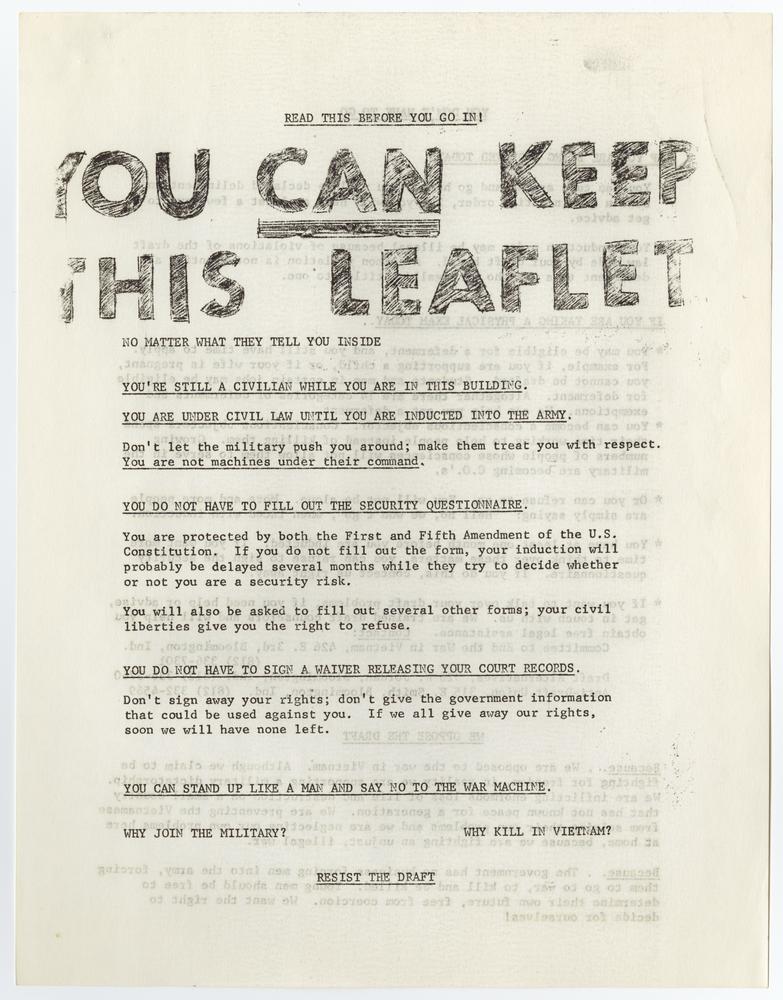
All in all, the history of the Eggshell press is fascinating. To me, it makes sense and fits right in with the social movement that was occurring at the time. In a decade where citizens of the United States were beginning to fully realize how much power and impact they had when it came to changing American society and politics, the Eggshell press served a great purpose and allowed Indiana University students to voice their concerns and ideas. One of my favorite publications from this collection can be found in the “Organizations” series and is called Committee to End the War in Vietnam, 1967-1968. In this group of publications, there are several pieces regarding resisting the draft, President Lyndon B. Johnson, and the promotion of peace and love. Out of these, I found myself drawn to the leaflet that discussed resisting the Vietnam draft. The thing that drew me towards this specific print is that it points out what rights you have as a citizen and student and how they apply to the draft. For example, in the leaflet, it has lines such as “YOU’RE STILL A CIVILIAN WHILE YOU ARE IN THIS BUILDING. YOU ARE UNDER CIVIL LAW UNTIL YOU ARE INDUCTED INTO THE ARMY. Don’t let the military push you around; make them treat you with respect. You are not machines under their command” and “YOU CAN STAND UP LIKE A MAN AND SAY NO TO THE WAR MACHINE. Why join the military? Why kill in Vietnam? RESIST THE DRAFT.” These lines stuck out to me because of how direct and serious they were presented. It made me realize how serious of a matter this issue was to students, especially the ones who were part of the Committee to End the War in Vietnam at the time. It also forced me to consider how widespread this opinion on the Vietnam War and the draft was across the country. Because not only were students on IU’s campus protesting this event, celebrities and athletes such as Mohammad Ali were as well. And even though it meant risking your reputation and life as a free citizen, they were willing to put it all on the line in order to stand up for what they believed in.
Due to the fact that we, as a nation, are currently in a period of strong division and opposition, the Eggshell press was something I could relate to. Even though the issues they are covering and promoting are not the same, there are a lot of parallels to what we are seeing and experiencing today. In the end, the Eggshell represents what we, as both students and citizens, have the power and right to do as Americans. We deserve to have our voice heard and if we try hard enough, it will be.
______________________
Martha Vicinus, Women’s Studies, and 1970s Feminism by Meredith May
Almost every college student can say they have heard of a gender/women’s studies course, or that they have met a gender/women’s studies major. This has not always been the case, of course. At Indiana University in particular, women’s studies became a part of the content offered in the year 1973. A woman named Martha Vicinus was a faculty member from within the English department, and she was integral in aiding the development and popularity of these courses. Upon examining the Martha Vicinus papers available at the University Archives, it becomes evident that there was an extreme amount of dedication of herself and other faculty members to create courses and education surrounding women, their history, great works, and the problems they faced in that day in age.

Martha and her colleagues not only worked to offer classes at Indiana University relative to women’s studies, but they also hosted the Midwest Women’s Studies Conference and something they called “Brown Bag Luncheon Discussions”. These discussions allowed for presentations of information relative to Women’s Studies and beyond over a light lunch. The plan for one such event is as follows “Judith Davis of SPEA will present information on ‘How to Get a Job.’ Ms. Davis, who conducted an earlier luncheon discussion on job discrimination, will talk about such problems as writing resumés, interviewing for jobs, and finding a job that fits one’s interests. She will also discuss assertiveness training techniques which have been developed to simulate job interview situations and to teach the job applicant how to present her/himself in the most positive possible manner.” As evident with this quote from a paper titled News From Women’s Studies, the luncheons were not only directed at and about women, they were also inclusive of men.
They regularly met in a group they called the “Women’s Studies Coordinating Committee”, where they planned and discussed possible events and programming that they would sponsor on campus. The committee came together nearly every week, and members held regular correspondence with one another. One document alludes to their being approximately 13 members in the period from 1974-75, Martha being one of them. This committee was responsible for the aforementioned Midwest Women’s Studies Conference, and thus organized the panels, workshops, and “nuts and bolts” of the occasion. They also were the sponsor and coordinators behind the Brown Bag Luncheons.

The conference was held on April 4th, 5th, and 6th in 1975. It offered seminars on starting women’s studies programs, classroom techniques and curriculum, films, panels and much more. These took place in Ballantine Hall and Woodburn, beginning at 8:30PM on Friday and ending at 4:00 PM Sunday, making it a weekend chock full of content. The committee made every possible effort to allow women to attend, making available some limited free housing for the conference, but also providing information on hotels and restaurants. The registration materials provided pricing for hotel rooms in Bloomington and estimated cab fares from Indianapolis to Bloomington, as well as the likely cost to rent a car. They even went so far as to have a day care available that was at no additional cost as it was built into the registration fee.
Similarly, the women’s studies content offered to students for credit on campus was incredible and varied. In the fall of 1975, there were approximately 22 courses “devoted to the study of women” available to students at Indiana University. These came from many different departments, from Forensic Studies to English. Examples of these courses include “Feminism and Morality”, “Clothing and Culture”, and “Sociology of Family Systems”. The content of the offered classes emphasized representation of women in all fields, and included information on their roles in history, the arts, and the family. Some of the courses had a greater focus on gender and sex itself rather than just the actions and depictions of women. A year prior, in 1974, the program began to offer grants to both students and faculty in amounts ranging from $25 to $500, which were able to be spent towards additions to the Women’s Studies program or relative research.

The 1970s can be and are credited with the rise of feminism. The efforts by Martha Vicinus and the faculty that worked to expand collegiate education to be inclusive of women in the 1970s are a remarkable implementation of the ideology of the feminist movement and equality of the sexes. The women involved with these projects created an atmosphere on campus that can be credited with keeping up with the times; as feminism and a focus on women and their worth became a part of counter culture in the United States, it did the same on Indiana University’s campus. Arguably, Indiana University took this counter-culture a step further by having it be established and cultivated by faculty, making it less a part of counter-culture and more-so a part of the culture on campus as whole.

This culture of feminism continues on campus today with many groups on campus advocating for feminist beliefs or in the name of feminism itself. Today, nearly 45 years after the women’s studies office came into existence, Indiana University Bloomington offers a Bachelor of Art Degree in Gender Studies, as well as a Master of arts and a Philosophical Doctorate in Gender Studies. It likewise offers minors in these areas and has an entire department dedicated to it within the College of Arts and Sciences. Gender studies envelops curriculum regarding women’s studies, and is described by the department as “ focuse[d] on the complex interrelationships between sexed bodies, gendered identities, and sexualities through diverse methodologies and far-ranging institutional and interpersonal locations.” Thus the current program serves and surpasses the intent of Martha and her colleagues.
The Indiana University Archives located in Wells Library holds the Martha Vicinus papers, which include details surrounding the Women’s Studies program at Indiana University and Midwest Women’s Studies Program, in addition to papers and correspondence on other Women’s Movement and union efforts within Bloomington and Indiana obtained by Martha Vicinus and her family.
Leave a Reply